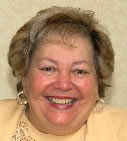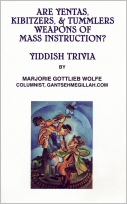  
|
Marjorie Gottlieb Wolfe

Syosset, New York
  
|

The word "balance" has many meanings. There's the proper balance between spiritual work, and physical activity. There's the importance of balance in your golf swing. Weight and balance is a matter of "ehrnst" (serious) concern for all pilots as well as other people involved in the flight. Any aircraft which is out of balance or "ibervog" (overweight) is dangerous to fly. Not to mention deadly.
According to Malkie Janowski (Chabad.org), the Yiddish word for balance is "belansiren."
I've seen the Broadway show and movie, "Fiddler on the Roof" many times. The part of Tevye has been played by Zero Mostel, Herschel Bernardi, Theodore Bikel, Leonard Nimoy, Chaim Topol, Harvey Fierstein, and Alfred Molina. It has widespread appeal, and not only in America. When the play was produced in Japan, according to Theodore Bikel, local theatergoers inquired whether it was true that Fiddler had been a huge success in America. When they were told that indeed it had been, they shook their heads in bewilderment. "Strange," they said, "but it's so Japanese!"
Even theatre mavens have asked questions like, "Why did Zero Mostel 'deedle dum' and why is Tevye a true mensch? (He gives himself to each new challenge, and makes each difficult decision with a strong mind and a BIG HARTS.) When the song "Tradition" ends, why does Teyve point out a fiddler on the roof? Is Fiddler as relevant to our lives today as it was in 1910, when the story is estimated to have taken place? When Zero Mostel played Fiddler at a theatre-in-the-round, did he actually sit on a patron's lap in the audience? When he sang the duet, "Do you Love Me?" with Golde, then played by Thelma Lee, did Zero run up the aisle in the "finsternish" (darkness) and shout to the audience, "And that night Tevye had Golde!"? Yes, he did!
The big question for me is, "What is the significance of the fiddler on "der dakh" (the roof)? Is the fiddler a metaphoric "dermonung" (reminder) of the Jews' ever-present fears and danger?
I think a fiddler on a pointed roof would be in a "umzikher" (precarious) situation. While sliding his bow across the instrument, he'd have to be "opgehit" (careful) not to fall off the roof to one side or the other. Only with great BALANCE --"belansiren''--can he play the best music he can.
When I asked Rabbi Moshe Newman (asktherabbi.org) about the significance of the fiddler and the word "balance," he replied, "...what I recall is that the theme is the conflict of cultures, generations, religious beliefs, financial needs and more--and the Jew's special difficulties at that time of the story (and throughout history) to balance a "Jewish" life in the face of constant change and challenges. Interesting question!"
Dr. David Roskies, at the Jewish Theological Seminary, wrote, "He [the fiddler] is lifted from the paintings of Marc Chagall.
As Tevye and his family begin packing to leave Anatevka, the mythical town in which Fiddler on the Roof is set, Tevye motions for the fiddler to come along. The film ends with the fiddler following Tevye down the road, playing the "Tradition" theme. Tevye says, "Our lives would be as shaky as a fiddler on the roof."
| A | B | C | D | E | F | G | H | I | J | K | L | M |
| N | O | P | Q | R | S | T | U | V | W | Y | Z |


| Yiddish
Stuff Jewish Humor Schmooze News More Majorie Wolfe |
Principle Jewish Stories All Things Jewish Jewish Communities of the World |